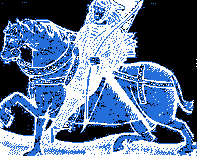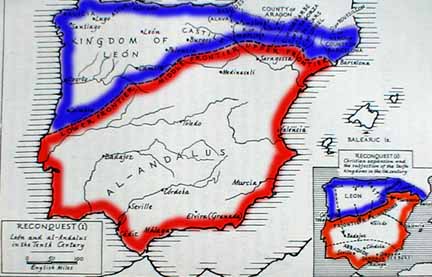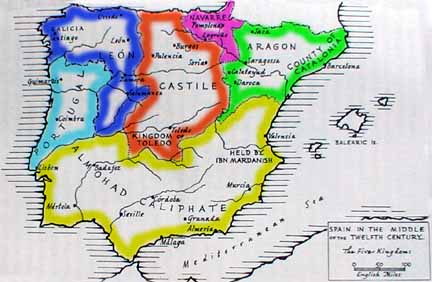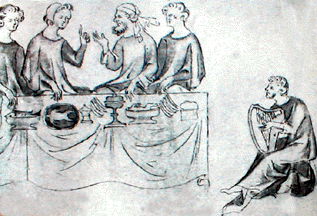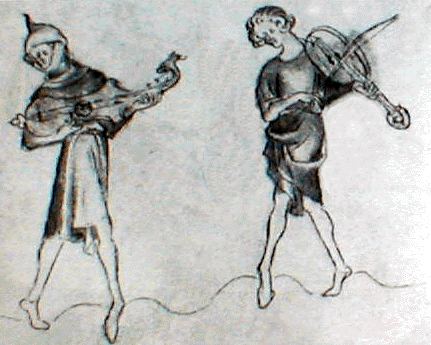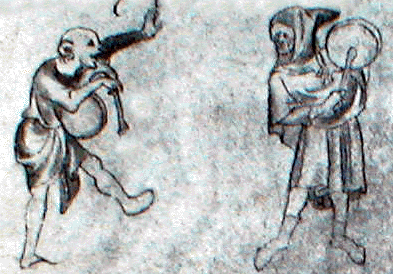Alice de Laci was the heiress of the honours of Pontefract and Clitheroe. Her betrothal in 1292 and marriage in 1294 ensured that these properties passed to her husband Thomas Plantagenet, who eventually became an earl in five counties, Lancaster, Leicester, Derby, Lincoln and Salisbury [Wiltshire]. This gave Thomas tremendous military power in the North, which he used to challenge Edward II. Alice was barely nine years of age in 1294 when her father, Henry de Laci, gave her away. In this short period of time Edward I made John II Balliol King of of Scotland who occupied the position from 1292 to1296, rather than ruling. John Balliol* married Isabel de Warenne, daughter of John the 7th earl of Warenne lord of the manor of Wakefield and Sandal Magna, Conisbrough and Lewes. As such Isabel 'ruled' with her vassal husband as Queen of Scotland.* John Balliol probably met his future wife whilst waiting at Sandal Castle to invade Scotland. Henry de Laci became a close confidant of Edward I and in 1278 received the earldom of Lincoln and Lordship of the honour of Pontefract. In 1272 Edward I granted the right for Henry to hold a market at Almondbury on each Monday. Henry died on 5th February 1311 and was buried at Old St. Paul's, London.
. Old St. Paul's 1314-1315 [Ann. Paul. p. 277.]
Henry had two sons and two daughters, the first three children
pre-deceased him. The only
surviving child was his youngest daughter Alice.
Alice inherited the Laci estates and succeeded her
mother as Countess of Lincoln on the 5th February 1311
having already entered into a marriage contract
at the age of nine in 1294 with Thomas Plantagenet,
later Earl of Lancaster, Leicester, Derby, Lincoln
and Salisbury.
By 1312 Gaveston, Edward II's favorite, had been executed on
Thomas of Lancaster's lands. Gaveston
had long been a thorn in Thomas's side after
Thomas lost in a joust and Gaveston had derided him with
the nick-names, 'The Fiddler', and 'The Churl'. No doubt these
were a references to Thomas's perceived political abilities,
his musical leanings and his Northern manners. In 1317, it was alleged
by Thomas that his wife Alice had been abducted
forcibly from her castle at Canford Magna near Wimborne,
Dorset. This was carried out by the men of
John 8th Earl Warenne of Lewes, Sandal Magna
and Conisbrough,
probably with the connivance
of Edward
II. Alice had inherited Canford castle through her mother Margaret
Longespee. The Warenne side of the arguement suggests she had been
adulterous with Eubulo Le Strange, John de Warenne's squire, whom she
eventually married. Secondly, before 10th November 1324, Alice was taken
to earl Warenne's castle at Reigate in Surrey under the guard of Richard
De St. Martin a retainer of Warenne. This gave rise to a private
war between Warenne and Lancaster which appears to have continued for
at least 25 years between barons in the honour of Ponterfract and those
in Warenne's former manor of Wakefield, the so called 'Elland Feud'.
John de Warenne surrendered Wakefield, his other northern manors and
those in North Wales to Thomas earl of Lancaster in 1318. This gave Thomas
even more influence in the North, particularly Yorkshire. Eventually,
Edward II patched up earl Warenne's and Thomas's disagreements but
this lasted no more than five years when Thomas was captured at Boroughbridge
and executed. After the death of Eubolo in 1335, Alice married for a
third time before 23rd March 1336 to Hugh De Freyne, baron Freyne [d.1336/7].
Alice died without issue from any of her marriages on the 2nd of October
1348 at her Castle of [Old] Bolingbroke, Lincolnshire and was buried
at Barlings Abbey in the same county although Alison Weir incorrectly
gives this as Birling, Kent.9[p77] The Two Henry's of the Honour of Pontefract
Henry Plantagenet, 3rd Earl of Lancaster and Earl of Leicester [b1281 d.1345]. Early in his career, Henry was summoned to parliament about the year1299 at which time he is described as being of the Lancaster estates, which included Pontefract. The following year saw him involved in the seige of Caerlaverock After the Lancastrian rebellion was crushed in 1322, Henry became a figurehead for the rebels and for a time lived as a fugitive.8 p.108 Between March 1322 and November 1323 contrariants from
the Battle of Boroughbridge who had escaped are thought to have been
hiding as outlaws throughout Yorkshire and particularly the Barnsdale
area. Here they could make a dishonest living from the commercial and
ecclesiastical traffic which moved north and south along one of
England's major arterial roads. This traffic seems unabated, even
today. Henry was Thomas's, the Earl of Lancaster's brother, but he had
not been involved with the rebellion and thus succeeded to the
confiscated lands, now regranted by Edward II. These lands included
the manor of Wakefield, Sandal Castle, Conisbrough Castle and the
honour of Pickering. By loyalty to the king's cause, or at least
by retaining neutrality, he had been invested by 1324 as
the earl of Leicester. As the reign of Edward II gradually unfolded, it
was obvious that the barons were becoming displeased with their
king. Because of the perceived unsavoury lifestyle of Edward II, the
'Lords Ordainers', a committee of twenty-one , was established,
led by Henry Plantagenet, earl of Lincoln. This committee drew up,
by 1311, forty-one articles known as the Ordinances to
try to control the king. As a member of this committee Henry was one
of the main forces behind the removal of Edward II from the throne. In 1327 after Edward II's abdication
in favour of his son, Edward II was placed in the custody of
Henry of Lancaster at Henry's castle of Kenilworth. Two months later, Mortimer
fearing that Henry was planning to rebel, the king was moved to his final
place of imprisonment in Berkeley Castle. Phillips and Keatman, without
following it up, suggest that Henry earl of Leicester was a model for
the ballad character Sir Richard at the Lee. This was because he was
a noble surrounded by contrariants and was often described as 'a gentle
and courteous knight' almost the same wording as is used in the
Geste to descibe Sir Richard at the Lee. Henry Plantagenet of Grosmont
[b.1300 d.1361] succeeded his father Henry the 3rd earl in
1345, inheriting the Honour of Pontefract amongst other lands.
If his father had been busy, Henry of Grosmont was even more
involved in the Scottish campaigns, French Wars and diplomacy with
the King of Castile and Leon. In the year of his succession he was summoned
on the 11th June to set out for Gascony [Gascogne] from Southampton with
men-at-arms and archers. In 1337 he had been made Earl of Derby and by
1352 his valiant efforts in war had secured himself the heady title of
Duke of Lancaster. Edward III had him installed as
one of the first of twenty-six knights of the Garter at St. George's
Chapel, Windsor Castle. Henry of Grosmont died of the Great
Plague or Pestilence on 24th March, 1361
which had appeared in England about 1348. Henry of Grosmont produced two daughters, Maud and Blanche.
The eldest, Maud, died without issue. The second, Blanche Plantagenet,
married John of Gaunt (Ghent),
earl of Richmond, duke of Lancaster [d. February 1399]. The poem,
The Book of the Duchesse, written by
Chaucer is believed to have been written for Blanche,
John of Gaunt's first wife. Through Blanche, John's
pedigree produced the Lancastrian line, whilst his
two brothers led to the line of Yorkists both of
which collided during the 'War of the Roses'. John's
third wife, Katherine Swynford [nee Roet] was the sister
to Philippa Roet who married Geoffrey Chaucer, the poet.
It is believed that Chaucer was invited by John of Gaunt
to Pontefract Castle on a number of occasions between 1396,
the year of John's marriage to Katherine Swynford and John's
death in 1399. If the legend of Robyn Hode of Barnsdale
were already airborne then Chaucer's passage through Barnsdale
would have been of consequence. See text
file of John of Gaunt's descendants.
From above we note the determination of a Paston player to go to 'Bernysdale' which may indicate that this servant of the Paston's had left the Paston's without notice or could find another venue for his talents in the Savile lands of the honour of Pontefract or /additionally he wished to visit the countryside of the heroic characters he played in the primeval ballad "A Lytell Geste of Robyn Hode".The Paston's were patrons of minstrels and balladeers, probably retaining them in their households, and were obviously familiar with the Robyn Hode ballads so far developed, albeit the letter above was written some one hundred and seventy years after Robert III Butler's death. Recent findings indicate that the copy of Robin Hood and the Potter in Cambridge University Library, another early ballad printed about 1520, belonged to John Paston's bailliff, Richard Calle. Calle had married Margery Paston a daughter of John Paston senior in 1469. A complex set of circumstances surrounds the family and its involvement as patrons to the arts of minstrelsy and balladry. We might ask here whether the playwright Anthony Munday garnered the idea of the 'Earl of Huntingdon' from the Hollands and 'Lord FitzWalter' from Robert Radcliffe, baron and Lord FitzWalter, 1st Earl of Sussex from such sources which were closely allied to the Pastons support for minstrelsy. Robert Radcliffe also married Margaret Stanley whose mother, Anne Hastings, was the sister to George Hastings, created 1st earl of Huntingdon in his line by Henry VIII. Radcliffe was a correspondent of the Paston's in the second half of the 1400's who later, in 1495, was beheaded by Henry VII . THE ROYAL BLOODED PASTONS MARRY INTO THE SAVILES THE RADCLIFFES MARRY INTO THE SAVILES Robyn Hode and the honour of Pontefract Chaucer and the honour of Pontefract There is a likely borrowing of Chaucer's taken from the a Robyn Hode proverb and used in his Troilus and Criseyde
P.V. Harris [3, p20] cites Ritson who noted that the 'Saynt Charyte' of the Geste is also found in Chaucer's Somnour's Tale :
A Somnor or Summoner was one who summond miscreants before an ecclesiastical court. The Sumnor in this case was operating in Holderness. Like Hunter's Robyn Hode, the valetti of King Edward II's chamber, Chaucer in 1367, was described as a yeoman or valetti* of King Edward III's chamber, before he achieved the status of 'squire' or an armigerous 'gentleman'. Geoffrey first served as a page in the household of Elizabeth de Burgh, Countess of Ulster, later becoming a Valet of the King's Chamber3 [p.88] * 'Dilectus vallectus noster' [our beloved yeoman or Franklin] In his Prologue to the Canterbury Tales Chaucer described the knight's yeoman :
Spanish Connections Liquorice In the 1300's, the monks at St. John's Priory, Pontefract were cultivating the root of a Mediterranean plant, liquorice. Liquorice is found as a native plant of Spain. It was John of Gaunt who may have returned with the herb to England in the1360's. Chaucer knew of this plant, probably from his visit[s] to Pontefract for he mentions liquorice in his poems as being used to sweeten the breath. Prologue to the tale of Sir Topas : There sprange herbes great and small, The liquorice and the setewall,* And many a clove-gilofre, And nutemeg to put in ale, Whether it be moist+ or stale, Or for to lay in coffer. *valerian, + new. They fetch'd him first the sweete wine, The Miller's Tale: And he himself was sweet as is the root Of liquorice, or any setewall. His Almagest, and bookes great and small, His astrolabe, belonging to his art, His augrim stones, layed fair apart On shelves couched at his bedde's head, His press y-cover'd with a falding red. And all above there lay a gay psalt'ry On which he made at nightes melody, So sweetely, that all the chamber rang: And Angelus ad virginem he sang. And after that he sung the kinge's note; Full often blessed was his merry throat. And thus this sweete clerk his time spent After his friendes finding and his rent. But first he chewed grains and liquorice he, To smelle sweet, ere he had combed his hair. Under his tongue a true lovebare, For thereby thought he to be gracious. Alone, withouten any company, Full fetisly y-dight* with herbes swoot, And he himself was sweet as is the root of liquorice, or any setewall. *neatly decorated The liquorice industry in Pontefract still continues its activity today with the production of 'Pomfret cakes' using extract from Spain, probably the best hard liquoice ever made [Barrett's]. For the 'Merrie England' of the 1300's some have also attributed the introduction of Morris* [Moorish or Morisco] dancing into England to John of Gaunt. John had a strong association with Spanish Aquitane from 1366 when he went to join his elder brother Edward 'The Black Prince" fighting in northern Spain. During this time he was married to his second wife, Constance [Constanza] of Castile and Leon. Constance's sister, Isabella married John's younger brother, Edmund de Langley who by 1385 was created Duke of York by Richard II. Edmund held thev manor of Wakefield with Sandal Castle, Wark in Northumberland and Fotheringay Castle.*A dance performed in ostentatious costumes, usually representing characters from the Robin Hood tradition such as Maid Marion and Friar Tuck. Bull Baiting There is a high probability that John of Gaunt introduced bull running to Tutbury. This version required minstrels to chase the bull across the nearby river Dove. The idea seems rooted in the primeval bull fights or even the bull runs of Pamplona [St. Fermin]. We know that the San Fermin Festival was already in existence for it is mentioned in the 1200's and 1300's as being run on 10th October each year. Pamplona lay in Navarre to the east of the Castillian territory of John's wife, Constance of Castile. The Spanish Constance lived part of her life at Tutbury and for a while kept her court here. John of Gaunt established a Court of Minstrels at Tutbury in Staffordshire in 1381.[11,12] Such a location will cause the Robyn Hode researcher to recall that the Tutbury area is another claimant for the legendary hero. According to Beryl Platts, Ranulf De Blondeville, earl of Chester was given Robert FitzOdo's lands in Warwickshire whilst Ranulf held Tutbury and Chartley Castles in Staffordshire near the manor of Loxley [Park]. Platts suggested that Robert FitzOdo [Eudo] held land at Hilderstone in Staffordshire in 1138 or 1166 and later aquired Loxley in Staffordshire. Not far away is the town of Huntington, perhaps after its name-sake in Huntingdonshire from its proximity to good hunting land, in this case, Cannock Chase then a forest. It was Ranulf who rebuilt and held Chartley castle and occupied Tutbury Castle in Staffordshire. Between these two fortresses lay a manor called Loxley in the county of Staffordshire. Later the De Ferrers family, earls of Derby, held Tutbury. According to one local oral tradition and ballad, Robin Hood married Clorinda, a sheperdess at Tutbury. This ballad by the King of the Fiddlers, described how Robin met Clorinda, Queen of the Shepherds, in Needwood Forest and travelled to Tutbury where they were soon wed. It is likely that this ballad actually sprang from a May Day celebration perhaps as early as John of Gaunt's time. The Tutbury Minstrel Court had an elected 'King of the Fiddlers' [King of the Minstrels] who held court and presided over the craft guilds in the five counties of the Midlands [Notts., Derbs., Staffs., Leics. and Northants.]. In 1266, the honour of Tutbury had been forfeited by Robert De Ferrers 6th Earl of Derby to Edmund Crouchback Plantagenet, the second son of Henry III and brother to Edward I. Robert De Ferrers had been unable to raise £50,000 in silver to recover his lands and title and was outlawed shortly after 1264. Robert's son, Thomas, by Alice De Leak [Leke] became Lord of Loxley, Staffordshire. It is often stated that Tutbury then passed through to Edmund's great grand-daughter Blanche Plantagenet [d.1329] who as we have shown above, married John of Gaunt. John encouraged the court of the ageing Edward III to become a breeding ground for romantic ballads including those of Robin Hood. However, what the histories rarely point out is that there was an interim period of twenty-six years, glossed over. This period in question occurs when Thomas the 2nd earl of Lancaster held the honour of Tutbury from the time his father Edmund 1st earl of Lancaster died in 1296 until Thomas's untimely execution in 1322 at Pontefract. Thomas was a royal family embarrassment for he turned upon the main royal line [Edward II]. But his family connexion did not save him and he paid the ultimate price. This terminating branch line of the royal Plantagenets is often overlooked or ignored by royal historians for it seemingly produced no further consequences. The De Ferrers had held the office of escheators for Tutbury and this office passed on the marriage of Isabel De Ferrers of Warton, Staffordshire to Nicholas Agard of Tutbury, who also now held the earldom of Derby. The earldom of Derby was finally absorbed into the Crown by right of the earls & dukes of Lancaster. The office was carried through to Dorothy Agard who was married, in 1647, to John Stanhope of Elvaston, Derbyshire. John became the escheator for Tutbury which carried as its symbol, a hunting horn. Morris Dancing John of Gaunt returned to England in 1396 with a troupe of Moorish dancers from Spain and it is thought that their dances were combined with the English Fool's Dance to produce the Morris Dance. After his marriage to Constance of Castile, the red lion and the three ostrich feathers on John's coat of arms were worn by the Morris dancers and Robin Hood in the May Day celebrations. Others think Morris dancing was introduced even earlier by the Spanish, Eleanor of Castile, Queen to Edward I. The dances were certainly common in the 1300's when they accompanied village merry-making. The Moors are cast as men with blackened faces [using burnt Spanish cork] and the Morris dancers represented King Charlemagne's men fighting the Islamic Moors who penetrated into Spain, from Morocco, in the 700's :
The importance of Charlemagne or Charles the Great to the European nobility should not be underestimated. Under this Emperor of the Western Holy Roman Empire and as King of the Franks, Charlemagne, amongst other achievements, stemmed the flow of Muslim expansion into Europe. He did this by campaigning in Spain and establishing a military zone or frontier between Muslim Spain and Frankish Gaul. In time, a reconquest was undertaken spreading south from Leon and Castile into Al-Andalus.10 The re-taking of the Iberian peninsula was not achieved until 1492, this event and the marriage of Philip and Isabella completely overshadowed another event, Christopher Columbus's discovery of America, which, because it did not show immediate lucrative rewards, was dismissed as a rather interesting distraction.
Morris dancing often accompanied the May Games and the gentry went a-Maying whilst the peasants cavorted around the village maypoles.7 During the reign of Elizabeth, stories of Robin Hood were very popular, the characters, Robin Hood, Maid Marian, Little John and Friar Tuck would become involved with the Morris dancing. The traditional fool's costume was often seen, as well as multiple dancers portraying a dragon which would often be ritually slaughtered by the dancers. Minstrels Regarding the families of Warenne, Laci and Thomas Plantagenet, J.C. Holt [p.113] expresses "All these had 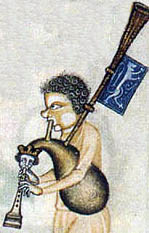 minstrels in their households in 1306".
Whitsuntide1306 was significant for it was the year
that Edward I invested his son Prince Edward [later Edward
II] as a knight. Prince Edward fom his infancy had been made
the first non-Welsh Prince of Wales. This title is held today
by Prince Charles. As with Charles's investiture as the Prince
of Wales, Prince Edward's investiture as a knight was a grand
occasion attended by many nobles and minstrels alike. Some of the
minstrels were harpists, fiddlers, acrobats fencers, heralds and
messengers. Many minstrels were part of the household of the
attending nobles, being liveried, and were often identified by
their master's name. Thomas of Lancaster had his vielle player and
two trumpeters, Alice his wife brought her harpist and waferer.
John, 8th earl Warenne had Geoffrey his harpist and Countess Warenne
[Joan de Bar, relative of Prince Edward] also brought her own harpist.
Adam of Clitheroe, King Edward I's harpist was also present.1[p
111-112]
minstrels in their households in 1306".
Whitsuntide1306 was significant for it was the year
that Edward I invested his son Prince Edward [later Edward
II] as a knight. Prince Edward fom his infancy had been made
the first non-Welsh Prince of Wales. This title is held today
by Prince Charles. As with Charles's investiture as the Prince
of Wales, Prince Edward's investiture as a knight was a grand
occasion attended by many nobles and minstrels alike. Some of the
minstrels were harpists, fiddlers, acrobats fencers, heralds and
messengers. Many minstrels were part of the household of the
attending nobles, being liveried, and were often identified by
their master's name. Thomas of Lancaster had his vielle player and
two trumpeters, Alice his wife brought her harpist and waferer.
John, 8th earl Warenne had Geoffrey his harpist and Countess Warenne
[Joan de Bar, relative of Prince Edward] also brought her own harpist.
Adam of Clitheroe, King Edward I's harpist was also present.1[p
111-112] Images of minstrels from the Queen Mary's Psalter early 1300's
There is informed speculation and there is................ Sources/References : 1. Holt, J.C. Robin Hood.Thames and Hudson, 1982. 2. Bellamy, John. Robin Hood an Historical Enquiry. Indiana Press. 1985. 3. Harris, P. Valentine. The Truth About Robin Hood. London, 1951. 4. Chambers E.K., Sir. English Literature at the Close of the Middle Ages. 1945 5. Hunter, Joseph. Great Hero of the Ancient Minstrelsy of England, Robin Hood, 1852. 6. Dobson, R.B. and Taylor, J. Rymes of Robyn Hood. University of Pittsburgh Press. 1976. 7. Alexander, Marc. A Companion to the Folklaw, Myths and Customs of Britain. Sutton Publishing, 2002. 8. Phillips, G. & Keatman, M. Robin Hood The Man Behind the Myth. Michael O'Mara Books Ltd. 1995. 9. Weir Alison. Britain's Royal Families : The Complete Genealogy. Pimlico. 2002. 10. Livermore, Harold. A History of Spain. George Allen & Unwin. 1958. 11. Young, History of British Music, 1967. 12. Dommett, Roy. What was Morris?, The [Morris Ring] Circular, Feb 1994, 23, p 3. 13. Elton G.R. England Under the Tudors. Methuen, London, 1963. 14. Weir, Alison. The Wars of the Roses. Jonathan Cape, London. 1995, p169. 15. Butler, Lawrence. Sandal Castle Wakefield. Wakefield Historical Publications, 1991. Link: Pip Wilson's Tutbury Pages © Copyright Tim Midgley 2006, revised 22d October 2024. |
||||||||||||||||||||||||||||||||||||||||||||||||||||||
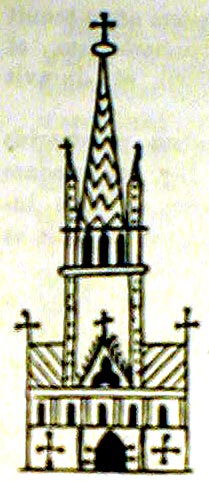
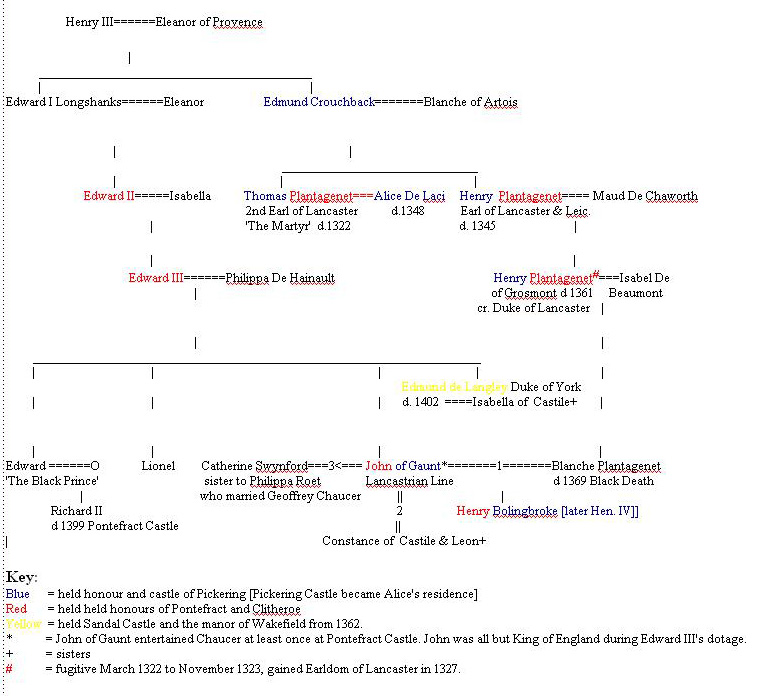
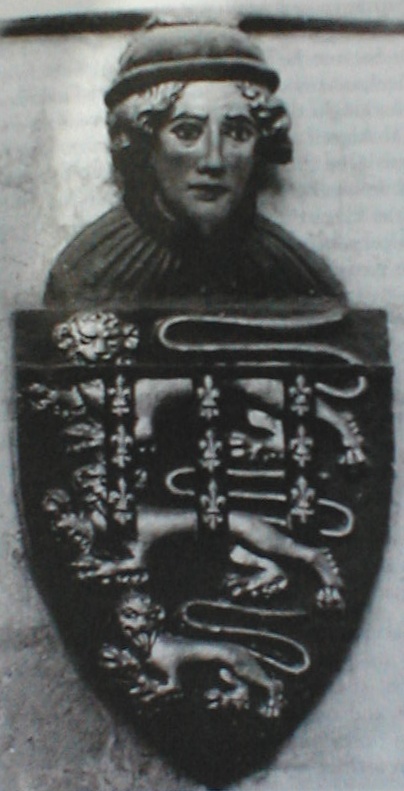 When Henry the third earl of Lancaster
died, Henry of Grosmont [above] succeeded to his
father's estates at age 45.
When Henry the third earl of Lancaster
died, Henry of Grosmont [above] succeeded to his
father's estates at age 45.